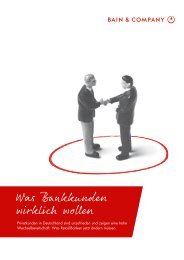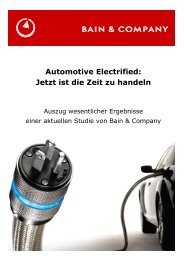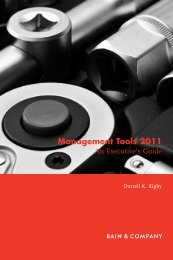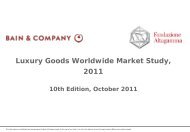Service now! Time to wake up the sleeping giant - Bain & Company
Service now! Time to wake up the sleeping giant - Bain & Company
Service now! Time to wake up the sleeping giant - Bain & Company
Create successful ePaper yourself
Turn your PDF publications into a flip-book with our unique Google optimized e-Paper software.
Example: Making <strong>the</strong> most of technical and process k<strong>now</strong>-how<br />
A manufacturer of food processing equipment has pelletizing and o<strong>the</strong>r processes. The Engineering<br />
a traditional strength in oilseed processing and Center not only generates healthy service revenues,<br />
handling. Its Engineering Center concentrates <strong>the</strong> but also streng<strong>the</strong>ns <strong>the</strong> company’s cus<strong>to</strong>mer relati-<br />
company’s experience, gained from working with onships and provides inputs in<strong>to</strong> its product develop-<br />
cus<strong>to</strong>mers engaged in multiple oilseed processing ment. While <strong>the</strong> first growth vec<strong>to</strong>r (growing services<br />
applications all over <strong>the</strong> world. It possesses techno- along <strong>the</strong> product’s life-cycle) offers <strong>the</strong> easiest path<br />
logical capabilities that cus<strong>to</strong>mers cannot afford on <strong>to</strong> service growth, <strong>the</strong> o<strong>the</strong>r service types help<br />
<strong>the</strong>ir own and offers unique cus<strong>to</strong>mer services <strong>to</strong> help develop longer-lasting cus<strong>to</strong>mer relationships and<br />
cus<strong>to</strong>mers optimize <strong>the</strong>ir processes and products, in- greater differentiation in <strong>the</strong> market. Thus companies<br />
cluding benchmarking, simulating s<strong>to</strong>cking, weighing,<br />
should investigate all three growth vec<strong>to</strong>rs.<br />
Spotlight: <strong>Service</strong> in china?<br />
China has traditionally been a difficult market for<br />
industrial goods services. Cus<strong>to</strong>mers in China often<br />
expect <strong>to</strong> receive free services from <strong>the</strong>ir equipment<br />
manufacturers, considering <strong>the</strong>se as a ticket<br />
<strong>to</strong> qualify for <strong>the</strong> next round of purchases. There is<br />
little demand for high-end consulting and life-cycle<br />
services, and most maintenance and repair jobs are<br />
performed by <strong>the</strong> cus<strong>to</strong>mers’ large in-house maintenance<br />
and repair centers.<br />
However, as China’s manufacturing sec<strong>to</strong>r matures<br />
and labor costs rapidly increase, <strong>the</strong> landscape is<br />
changing. Cus<strong>to</strong>mers are beginning <strong>to</strong> appreciate<br />
<strong>the</strong> importance of service, recognizing <strong>the</strong> benefits<br />
of a well-maintained plant. But a clear market strategy<br />
and a local Chinese service business model are<br />
essential. In our work we have identified a set of<br />
common <strong>the</strong>mes <strong>to</strong> be addressed by global OEMs:<br />
Clear segmentation<br />
Identify and target <strong>the</strong> market clusters with service<br />
potential. Typical criteria include:<br />
• Complex versus simple equipment<br />
• Importance of safety, precision, etc., versus<br />
importance of cost<br />
• Regulated versus unregulated environment<br />
• State-owned enterprise versus private<br />
entrepreneur<br />
• Western-style versus Chinese-style counterpart<br />
<strong>Service</strong> <strong>now</strong>! <strong>Time</strong> <strong>to</strong> <strong>wake</strong> <strong>up</strong> <strong>the</strong> <strong>sleeping</strong> <strong>giant</strong><br />
Localized business model<br />
OEMs must be open <strong>to</strong> redesigning products and<br />
services <strong>to</strong> local Chinese business practices. For example,<br />
<strong>the</strong>y may need <strong>to</strong> allow more service tasks <strong>to</strong><br />
be executed by <strong>the</strong> cus<strong>to</strong>mer’s technical staff or build<br />
complexity in<strong>to</strong> parts <strong>to</strong> prevent local copying. Ano<strong>the</strong>r<br />
issue is <strong>the</strong> price pressure on OEM spare parts.<br />
Many companies have started <strong>to</strong> develop special Chinese<br />
spare parts that meet local requirements not<br />
only in price, but also in specifications.<br />
Good market coverage<br />
Low demand for services has led OEMs <strong>to</strong> limit<br />
<strong>the</strong> number of service centers in China. But with<br />
emergency repairs being <strong>the</strong> most important single<br />
service, response time is critical. Therefore, OEMs<br />
should improve <strong>the</strong>ir basic service capacities in China<br />
with small local service bases centered on cus<strong>to</strong>mer<br />
clusters in China’s heavily industrialized areas.<br />
Parts availability<br />
Many Chinese cus<strong>to</strong>mers complain about unacceptable<br />
delivery times of spare parts. OEMs should<br />
address this by adapting <strong>the</strong>ir warehousing and delivery<br />
structures <strong>to</strong> suit <strong>the</strong>ir cus<strong>to</strong>mers’ needs.<br />
17
















